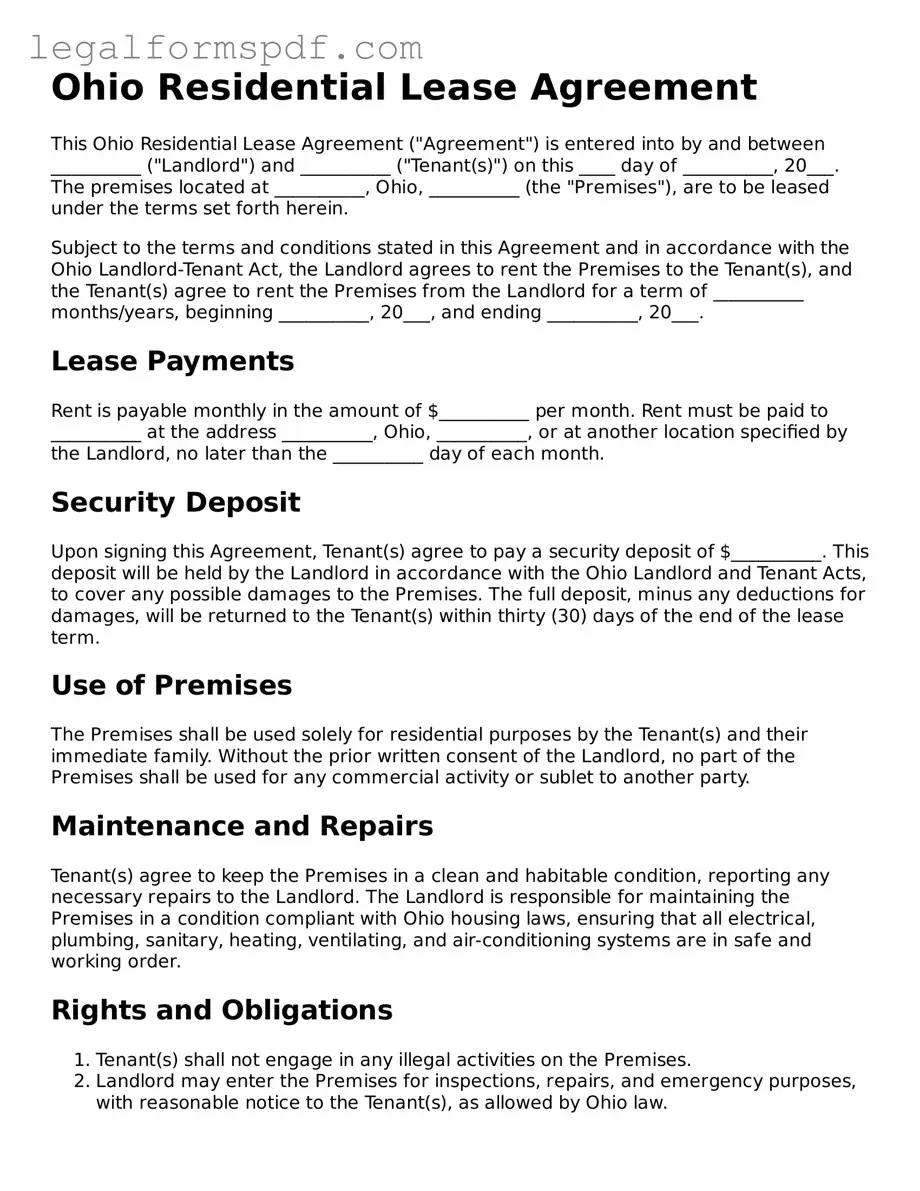Ohio Residential Lease Agreement
This Ohio Residential Lease Agreement ("Agreement") is entered into by and between __________ ("Landlord") and __________ ("Tenant(s)") on this ____ day of __________, 20___. The premises located at __________, Ohio, __________ (the "Premises"), are to be leased under the terms set forth herein.
Subject to the terms and conditions stated in this Agreement and in accordance with the Ohio Landlord-Tenant Act, the Landlord agrees to rent the Premises to the Tenant(s), and the Tenant(s) agree to rent the Premises from the Landlord for a term of __________ months/years, beginning __________, 20___, and ending __________, 20___.
Lease Payments
Rent is payable monthly in the amount of $__________ per month. Rent must be paid to __________ at the address __________, Ohio, __________, or at another location specified by the Landlord, no later than the __________ day of each month.
Security Deposit
Upon signing this Agreement, Tenant(s) agree to pay a security deposit of $__________. This deposit will be held by the Landlord in accordance with the Ohio Landlord and Tenant Acts, to cover any possible damages to the Premises. The full deposit, minus any deductions for damages, will be returned to the Tenant(s) within thirty (30) days of the end of the lease term.
Use of Premises
The Premises shall be used solely for residential purposes by the Tenant(s) and their immediate family. Without the prior written consent of the Landlord, no part of the Premises shall be used for any commercial activity or sublet to another party.
Maintenance and Repairs
Tenant(s) agree to keep the Premises in a clean and habitable condition, reporting any necessary repairs to the Landlord. The Landlord is responsible for maintaining the Premises in a condition compliant with Ohio housing laws, ensuring that all electrical, plumbing, sanitary, heating, ventilating, and air-conditioning systems are in safe and working order.
Rights and Obligations
- Tenant(s) shall not engage in any illegal activities on the Premises.
- Landlord may enter the Premises for inspections, repairs, and emergency purposes, with reasonable notice to the Tenant(s), as allowed by Ohio law.
- Pets are allowed/not allowed (circle one), subject to Landlord’s approval, and possibly additional deposits or rent.
Termination and Renewal
This lease shall terminate on the end date specified above, unless renewed or extended by mutual written agreement of both parties. Upon termination, Tenant(s) agree to return the Premises in the same condition as at the beginning of the lease term, reasonable wear and tear expected.
Governing Law
This Agreement shall be governed by the laws of the State of Ohio. Any disputes arising under this Agreement shall be subject to the exclusive jurisdiction of the Ohio state courts.
Agreement
By signing below, both the Landlord and the Tenant(s) acknowledge that they have read, understood, and agreed to the terms and conditions of this Agreement.
Landlord's Signature: __________________________ Date: ____/____/____
Tenant's Signature: __________________________ Date: ____/____/____
Tenant's Signature (if more than one tenant): __________________________ Date: ____/____/____
Note: This is a general template and may need modifications to fit specific circumstances and requirements. It is advised to review any lease agreement with a legal professional to ensure compliance with local laws and regulations.
